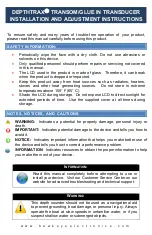
w w w . h a w k e y e e l e c t r o n i c s . c o m
STEP 1
Choosing a Mounting Location
Since the hull absorbs acoustic energy, transmitting
through the hull reduces the transducers
performance. Fiberglass hulls are often reinforced
in places for added strength. These cored areas
contain wood or structural foam which are poor
sound conductors. To achieve optimal performance,
find a location where the hull’s laminate is solid (not
cored).
To obtain the best performance, the transducer
should be mounted in a location where the water
flow beneath the hull is aeration and turbulence-
free. Try to mount the transducer as close to the
centerline of the boat as possible. Consult the boat
manufacturer for the best in-hull transducer
placement. If this information is unavailable, follow
the guidelines below.
A.
Outboard, Inboard/Outboard Powerboats -
Install as close to the stern and centerline
as possible.
B.
Inboard Powerboats - Install forward of the
propeller(s), shaft(s), and running gear, as
close to the centerline as possible. Keep in
mind that many Ski Boats have fins that you
need to avoid mounting near.
C.
Jet Boats - Install forward of the intake
grate, as close to the centerline as possible.
D.
Stepped Hulls - Install forward of the step,
as close to the centerline as possible.
E.
Sailboats - Install near the centerline of the
hull and forward of the leading edge of the
keel.
F.
Personal Watercraft (PWC) - Install forward
of the intake grate, as close to the
centerline as possible
(under the engine).
N
OTICE
:
If your hull is not SOLID fiberglass or up to 1/8th” Aluminum, this
transducer CAN NOT be mounted in-hull. Refer to the Transom
Mounting Instructions, or email us at support.norcrossmarine.com
to inquire about exchanging the transducer.




















